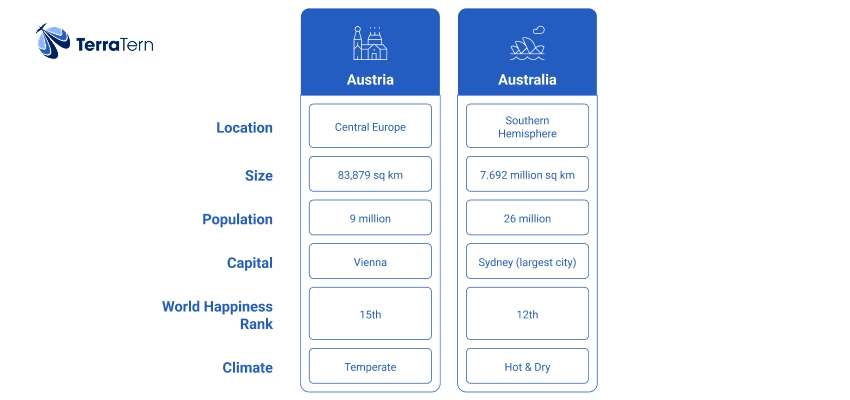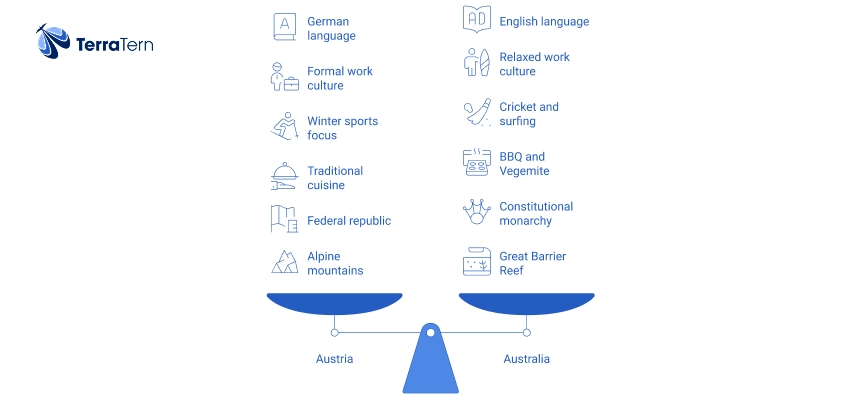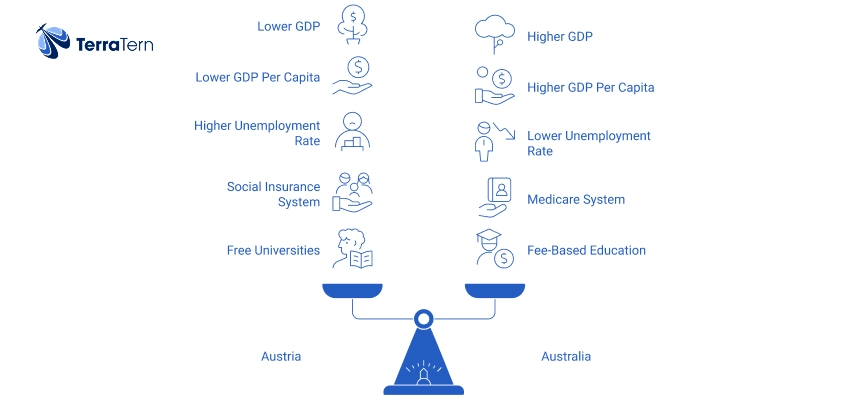Key Highlights
- Latest Facts and News
- Understanding the Difference Between Austria and Australia
- Geographical Difference Between Austria and Australia
- Education and Healthcare: Austrian vs Australian Systems
- Cultural Distinctions: Difference Between Austria and Australia
- Political Systems: Austria and Australia Compared
- Economic Comparison: Austrian and Australian Economies
- Tourism and Travel: Experiencing Austria and Australia
- Conclusion
Latest Facts and News
• Austria ranked 15th in the 2023 World Happiness Report, while Australia ranked 12th.
• Australia's population reached 26 million in 2023, while Austria's population is around 9 million.
• Austria joined the EU's borderless Schengen Area in 2024, enhancing European travel.
• Australia experienced record-breaking heatwaves in 2023, highlighting climate change concerns.
Understanding the Difference Between Austria and Australia

The names Austria and Australia are very similar, but there are many differences between Austria and Australia in terms of geographical location, education system, political laws, cultural identity, and ethnicity. Both countries are situated in different parts of the world and have unique things to offer. Despite many differences, these countries are equally beautiful and culturally strong. They are also financially stable and attract a lot of working professionals due to their strong economy.
Geographical Difference Between Austria and Australia
There are various difference between Austria and Australia in terms of geographical location. Here’s an overview of the geographical difference between Austria and Australia.
1. Location
- Austria: The country of Austria is located in Central Europe. Many powerful and beautiful countries, such as Germany, the Czech Republic, Slovakia, Hungary, Slovenia, Italy, Switzerland, and Liechtenstein, border it.
- Australia: Australia is a country and continent in the Southern Hemisphere. It’s an island nation with no land borders. The country is surrounded by two majestic water bodies: the Indian and Pacific Oceans.
2. Climate
- Austria: Austria experiences four distinct seasons due to its temperate climate. The hilly regions are mostly cooler and have snow almost yearly. The eastern parts alternatively experience mild summers and cold winters.
- Australia: The climate of Australia is generally hot and dry. However, the climate in Australia differs depending on the region and part of the country, as it’s a huge landscape. Generally, the northern part has a tropical climate, while the southern regions experience a temperate climate. On the other hand, the central desert areas are arid.
Also Read: How to Go to Australia from India for Job? Experts Guide
3. Size
- Austria: Austria is relatively smaller than Australia. This is one of the major difference between Austria and Australia. This country covers an area of around 83,879 square kilometres.
- Australia: Australia is the 6th largest country in the world. It covers an area of around 7.692 million square kilometres. The size factor makes a huge difference between Austria and Australia.
4. Terrain
- Austria: Austria is known for its high mountain peaks, such as the Alpine mountains and the Grossglockner. Apart from that, there’s also the presence of rivers like the Danube and plains on the country's eastern side.
- Australia: Australia has a wide variety of landscapes. Deserts, tropical rainforests, coastal beaches, and fertile plains exist in different country regions. Australia's terrain is mostly flat compared to Austria's mountainous terrain. This makes a key difference between Austria and Australia.
5. Time Zone
- Austria: Austria operates on Central European Time (CET). This makes a huge difference between Austria and Australia.
- Australia: Australia has multiple time zones, which include Australian Eastern Standard Time (AEST), Australian Central Standard Time (ACST), and Australian Western Standard Time (AWST).
Education and Healthcare: Austrian vs Australian Systems
Here’s a brief outline of the education and healthcare system difference between Austria and Australia.
Education System: Difference Between Austria and Australia
1. Austria

-
Follows a structured system with primary education, secondary education (split into general and vocational tracks), and higher education
-
Mandatory schooling from ages 6 to 15 for all the kids in Austria.
-
Public universities are mostly tuition-free for Austrian and EU citizens. There are small semester fees for non-EU students.
-
Austria is known for its high-quality education system, especially in technical and scientific fields.
-
The Primary language of instruction in the classroom is German. However, some courses are offered in English at the university level.
2. Australia

-
Divided into primary, secondary, and tertiary education. Secondary education is generally from 7-12 years.
-
Education is mandatory until the age of 16.
-
Australian universities charge tuition fees, but all students can access scholarships and other financial aid.
-
A strong TAFE (Technical and Further Education) institution system provides vocational qualifications for various trades and professions.
-
Australian universities are highly regarded globally, with a focus on innovation and research, particularly in fields like environmental science and medicine.
Healthcare System: Difference Between Austria and Australia
1. Austria:
-
Austria has a social health insurance system. This offers universal coverage to all Austrian citizens and residents.
-
High-quality healthcare services, with access to advanced medical facilities and specialised treatments.
-
Public healthcare is mostly free or low-cost, but private health insurance is expensive. However, getting treatment in Austria is affordable.
-
The healthcare system of Austria is primarily funded through taxes and social security contributions.
-
Austria has one of the highest life expectancies in Europe due to its excellent healthcare system.
2. Australia:
-
Australia has a world-class healthcare system, with high-quality hospitals and medical care available.
-
Medicare is Australia’s universal public healthcare system. It covers most of the health aid services for Australian residents and citizens.
-
Public hospitals have lower rates, whereas private hospitals are on the expensive side.
-
There’s usually a waiting time in public hospitals, but private hospitals can offer a faster service for emergency cases.
-
Australia boasts one of the highest life expectancies globally, reflecting the high standard of healthcare.
Also Read: Austria Visa for Indians: Types, Fees, Benefits & More
Cultural Distinctions: Difference Between Austria and Australia

There are many cultural difference between Austria and Australia due to their distinct people and community. Here's a table overviewing the cultural differences between Austria and Australia.
|
Category |
Austria |
Australia |
|
Language |
German is the official language, and it has various dialects. |
English is the official language, along with some other indigenous languages. |
|
History |
Long European history, part of the Austro-Hungarian Empire, known for classical music and Baroque architecture. |
Modern history was originally settled by Indigenous peoples and colonised by the British in the late 18th century. |
|
Cuisine |
Famous for Wiener Schnitzel, Sachertorte, and Strudel. Heavily influenced by Central European cuisine. |
BBQ culture, meat pies, Vegemite, and a focus on multicultural food due to immigration. |
|
Arts and Music |
A strong tradition of classical music. Known for opera houses, theatres, and rich artistic history. |
Known for indigenous art, modern music, cinema, and a strong outdoor festival culture. |
|
Sports |
Skiing, soccer, and winter sports are highly popular. |
Cricket, rugby, Australian rules football, and surfing are mostly played here. |
|
Work Culture |
Strong work ethic with an emphasis on punctuality, quality, and professionalism. |
Generally more relaxed, with a balance between work and entertainment. Flexibility and work-life balance are important. |
|
Public Holidays |
Christmas, Easter, Austrian National Day, and traditional Catholic holidays. |
Australia Day, Anzac Day, Christmas, Easter, and Queen's Birthday. |
|
Religious Influence |
It mostly follows Roman Catholic traditions, with religious holidays playing a major role in the culture. |
It is a secular society, but most of the people follow Christianity. |
|
Social Attitude |
Generally more formal and polite, with a focus on tradition and etiquette. |
Informal and friendly, with a relaxed social attitude. |
|
Festivals |
Viennese Ball culture, Salzburg Festival, Christmas markets. |
Sydney New Year’s Eve, Melbourne Cup, music and cultural festivals like Vivid Sydney. |
Note: These are some of the major cultural difference between Austria and Australia as per the latest research of our team members.
Political Systems: Austria and Australia Compared
There are many political system difference between Austria and Australia. Here’s an overview of the political differences between Austria and Australia.
1. Form of Government
- Austria: Austria has a Federal parliamentary republic.
- Australia: Australia has a Federal parliamentary constitutional monarchy.
2. Head of State
- Austria: The head of state is the President of the country.
- Australia: The British Monarch is the head of the state.
3. Legal System
- Austria: Civil law system based on Roman law.
- Australia: The common law system is based on British legal tradition.
4. Political System
- Austria: Multi-party system where coalition governments are common.
- Australia: Two-party dominant system (Liberal and Labor parties).
5. Federal System
- Austria: Federal system with 9 states.
- Australia: Federal system with 6 states and 2 territories.
6. Voting
- Austria: Compulsory voting was abolished, so there is a voluntary voting system.
- Australia: Compulsory voting for all citizens over 18.
7. Constitution
- Austria: The written constitution was established in 1920 and revised in 1929.
- Australia: The Constitution was established in 1901 and is still in effect with amendments.
8. Foreign Relations
- Austria: Focusing on neutrality has a strong role in UN and EU diplomacy.
- Australia: Close ties with countries like the United States and the United Kingdom.
Economic Comparison: Austrian and Australian Economies

Here’s an overview of the economic difference between Austria and Australia:
|
Category |
Austria |
Australia |
|
Economic System |
Social market economy, part of the EU single market |
Mixed-market economy with capitalist tendencies |
|
Currency |
Euro (EUR) |
Australian Dollar (AUD) |
|
GDP (Nominal) |
$490 billion USD |
$1.67 trillion USD |
|
GDP Per Capita |
$55,000 USD |
$65,000 USD |
|
Key Industries |
Machinery, chemicals, steel, vehicles, tourism, food processing |
Mining (iron ore, coal), agriculture, finance, tourism, education, and manufacturing |
|
Unemployment Rate |
5-6% |
3-4% |
|
Inflation Rate |
6-7% |
5-6% |
|
Major Trade Partners |
Germany, Italy, the U.S., Switzerland, China |
China, Japan, U.S., South Korea, India |
|
Public Debt |
80% of GDP |
45% of GDP |
|
Economic Challenges |
High taxes, ageing population, energy dependency |
Commodity price fluctuations, environmental concerns, high household debt |
Note: These are some of the major economic differences between Austria and Australia, as per our expert team members' latest research.
Tourism and Travel: Experiencing Austria and Australia
The cultural landscapes of Austria and Australia are very distinct, which provides a great travel experience for tourists. Both places offer various kinds of cultural beauty, which makes a tourism difference between Austria and Australia.
Austria Key Experiences:
1. Capital City
The capital city of Austria is Vienna. The capital city is famous for its imperial places such as Schonbrunn and Hofburg. Apart from that, the city is also well-renowned for the rich musical history of composers like Mozart and Beethoven.
2. Top Tourist Attractions
The top tourist attractions in Austria include Schonbrunn Palace, Hallstatt, Salzburg Cathedral, and Vienna State Opera. These places include stunning architectural marvels along with nature’s beauty. Also, there are many world-class museums, which add to the place's historical significance.
3. Natural Wonders
Austria has many attractive natural wonders, such as the Austrian Alps, the Danube River and Lake Neusiedl. Apart from that, there are also salt mines and crystal-clear lakes in Austria, which are just picture-perfect.
Also Read: Which Country is Best for Job Opportunities in 2024? Updated
4. Wildlife
The wildlife of Austria is very distinct due to the presence of animals such as alpine ibex, deer and marmots. Apart from that, Austria also has a large variety of bird species.
5. Best Time to Visit
The best time to visit Austria is around December to March to experience the Austrian winter season. This is the best time for outdoor activities such as skiing on snowy mountain peaks. But the best time to visit is around April to October if you want to feel the mild summer season.
Australia Key Experiences:
1. Capital City
The capital city of Australia is Sydney, which is also the largest city in the country. Sydney is iconic for the Sydney Opera House and Harbour Bridge. Apart from that, the city has many famous beaches like Bondi and Manly.
2. Top Tourist Attractions
The top tourist attractions of Australia include places like the Great Barrier Reef, Sydney Opera House, Uluru, Street Art, Botanical Garden and Bondi Beach. All these places enhance the natural and architectural beauty of the place.
3. Natural Wonders
The Great Barrier Reef is one of the world’s most spectacular underwater ecosystems. This natural wonder of Australia attracts many tourists to the country. The place is also ideal for adventurous activities such as snorkelling and scuba diving.
4. Wildlife
Australia has a unique fauna, including kangaroos, koalas, emus and wombats. Apart from that, Australia's marine life is diverse and vibrant.
5. Best Time to Visit
The best time to visit Australia is during the spring season, from September to November. The country is beautiful and vibrant at this time. People can also visit Australia from March to May to experience more pleasant and relaxing weather.
Read More: Advantages and Disadvantages of Travelling Abroad in 2024
Conclusion
In conclusion, there are several difference between Austria and Australia. Both these countries are culturally, historically, economically and financially rich. They both have a beautiful cultural landscape and strong art and music traditions. Both countries also attract a lot of working professionals from all around the globe due to their strong economies. These countries have constantly developed financially as well as ecologically. These countries have good healthcare and education systems, which enhance the living experience of their citizens.
While both countries share similar-sounding names, they differ vastly in geography, language, climate, and cultural experiences. To find ways to immigrate to Austria or Australia, you must contact TerraTern right away. Being immigration experts, TerraTern can be your go-to for all your immigration needs!






